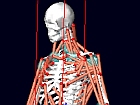Empa – capable partner for the Medtech industry
«Spare parts» for humans – a challenge formaterial scientists

|
Caption: Body model of the human movement apparatus including muscles..
|
|||
| Materials must be tolerated by the body Exactly how the human body reacts to an implanted “foreign body” is something that Empa is investigating, using test tube methods, among others. Such «in vitro» research is carried out by Katharina Maniura of the «Materials–Biology Interactions» Laboratory. She evaluates the suitability of implant materials using cell cultures, a risk analysis procedure which is important because the materials used may have negative effects on cell functions. Instead of the cell lines usually used for these types of tests Maniura uses “adult” stem cells which are found in many tissues such as body fat or bone marrow, and which can be collected during hip operations. Whilst cell lines are often derived from tumorous tissue, and therefore have abnormal metabolisms, stem cells lie dormant in the body until they are required to replace damaged cell material. Only when necessary do they begin to grow into specialized cells typical of a particular tissue. However, a number of preparation steps are needed for the adult stem cells to differentiate into the bone marrow cells used for the tests. When this us accomplished, however, they provide important information about how human cells react to different materials, and depending on the results it is possible to determine if the material being tested is suitable or not for use in implants. |
|||
| A «sensation» was Manfred Zinn’s description of the fact that the US Food and Drug Administration last year certified a polymer manufactured by microbial methods – so called biopolymers. Zinn, a staff member of Empa’s «Biopolymers» Laboratory, is also working on the development of such materials in the institution’s bioreactors. Their great advantages are that they are biodegradable and can be tailor made. Empa staff are currently working on projects investigating the use of biopolymers for medical purposes such as temporary layers between hip implants and the bone surfaces. After the operation the layer encourages the growing together of the implant and the bone structure, following which it spontaneously dissolves. Another project deals with artificial tendons which can be inserted after a tendon rupture and which biodegrade as soon as the body repairs the damage by regenerating the necessary natural tendon. | |||
| Further biodegradable implants were presented by Patrik Schmutz of Empa’s «Corrosion and Materials Integrity» Laboratory. Implants of magnesium, for example, are use as stents to keep open constricted blood vessels or as pins and plates for stabilizing bone fractures. The advantage is that these devices decompose with time when they are in contact with bodily fluids, obviating the need for a further operation to remove the implant. And magnesium is not just biocompatible; the body actually needs the element for numerous metabolic processes. | |||
| Stringent requirements for long term implants When an implant is to remain in the body for an extended period then its dimensional stability, ageing behavior and resistance to wear are all of extreme importance. How materials and implants are biomechanically tested in this context was described by Bernhard Weisse of Empa’s «Mechanical Systems Engineering» Laboratory. Weisse and his colleagues use a range of tests to simulate static, dynamic and shock loads in the physiological environment. These days such processes are increasingly studied using computer simulations, and the capabilities and limits to the programs in use were described during the presentation. |
|||
|
|
|||
|
In order to create computer simulations of the way humans move, the researcher himself sometimes has to play the role of experimental guinea pig. The picture on the left shows Bernhard Weisse wearing a special suit fitted with optical sensors. On the right is a computer simulation. | ||
|
|
|||
| Implants are frequently given surface coatings to increase their useful lifetime. “Today everything that must have a long service life is surface coated, from drill bits to computer hard drives,” maintains Roland Hauert of Empa’s «Nanoscale Materials Science» Laboratory. Some time ago he developed a diamond-like carbon coating for applications in the engineering industry. The new coating not only improves the frictional properties of machine parts, but because it has very high resistance to wear it is also used on implants. The adhesive layer between the coating and the substrate is of critical importance, however. If it is not perfect then cracks may develop in the coating allowing the ingress of bodily fluids which then corrode the substrate. As a consequence the implant must be removed. Hauert is therefore analyzing the interface layer between various different coatings, with the aim of predicting how long such an interface remains intact – and with it the implant. | |||
| Finally Pierangelo Groening, a member of Empa’s Board of Directors, raised the prospect of coatings on the nanometer scale – coatings which would make nanoparticles even harder, thus reducing wear on implants to a minimum. “We are developing these kinds of coatings at Empa and we are interested in developing tailor made coatings in partnership with you,” he said, advertising the institutions keenness to establish cooperative projects with industrial partners. | |||
|
|||
|
|||

